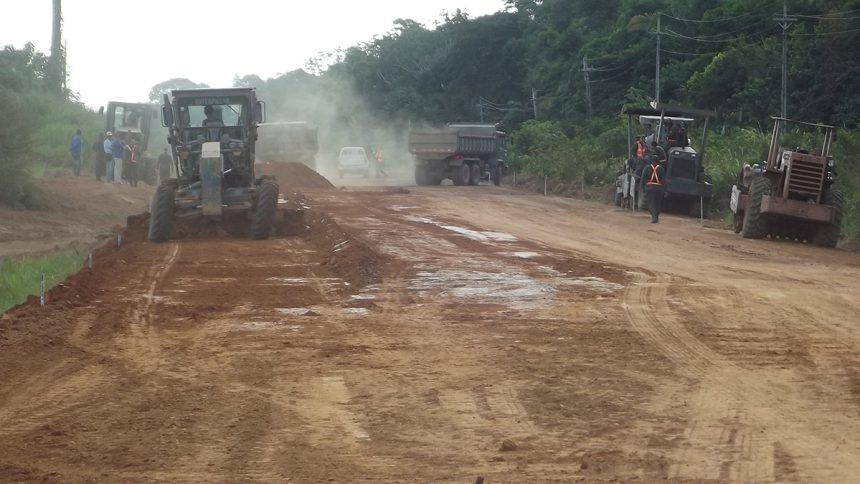
Brazilian institutions are in a tug-of-war over an 870-kilometer road connecting two state capitals: Manaus, the capital of Amazonas, and Porto Velho, the capital of Rondônia. Though a project to repave the road (BR-319) could stir economic development in the region, scientists worry construction could drive deforestation, increase greenhouse gas emissions, reduce biodiversity, and violate the rights of Indigenous peoples.
In a study presented at AGU’s Annual Meeting 2024 in Washington, D.C., researchers showed that the number of protected regions in Brazil that are crosscut by roads such as BR-319 could more than double over the next quarter century. Protected regions in Indonesia and Nigeria are similarly at risk, the researchers found. Additionally, roads often come with urban development that could further squeeze protected regions.
“The scenario is going to be catastrophic.”
“The scenario is going to be catastrophic,” warned Lucas Ferrante of São Paulo State University, who was not involved in the research.
One reason Ferrante uses such language is that construction of major thoroughfares such as BR-319 rarely stops at just one road. “There are several other nearby routes being planned to follow the paving of BR-319,” he said.
That trend has played out around the world, especially in forested areas with high rates of biodiversity such as regions of Indonesia and Nigeria, according to Burak Güneralp, an urbanization and land change researcher at Texas A&M University and a coauthor of the new study.
Roads Bring Development in Brazil
“By 2015, there were 187 protected areas cut by urban infrastructures in Brazil. If the country does not enforce the law to safeguard the remaining protected areas, there will be 425 of them impacted by urban development in 2050,” said coauthor Rakibul Ahasan, a product engineer at Esri in California.
Those figures come from a model designed to show how the expansion of road networks affects urban development and protected regions that Güneralp and Ahasan developed when Ahasan was a doctoral student at Texas A&M.
Most models of road development ignore the interactions between road network development and land use change, including urban growth, Güneralp said. “This, in turn, can lead to less accurate forecasts of road network development and also urban land change,” he continued.
To better forecast urban expansion, Ahasan and Güneralp borrowed methodology from a 2019 study. The researchers used data on urban land expansion, urban population, gross domestic product, and future scenarios based on Shared Socioeconomic Pathways scenarios.
To look at future road expansion, however, the pair developed their own model. “We did not have a previous framework at hand or anything,” Ahasan said.
They used a statistical method called regression analysis to see how transportation infrastructure and development influenced the expansion of urban areas between 1985 and 2015, using data such as road networks and land use change. That data came from 128 previously published studies.
The researchers then forecast the distribution of new roads after 2015 on the basis of urban center locations, existing roads, and economic drivers, Güneralp explained.
The result suggests that repaving BR-319 may lead to further road development in Brazil. The researchers made similar predictions about development in Indonesia and Nigeria. In Indonesia, urban areas may grow fivefold to sixfold by 2050. Nigeria could see the greatest increase among the three countries by 2050, expanding by 6.5–8 times.
Road Development Affects Habitats
“Protected areas in some of the world’s most biodiverse countries will face increasing pressure and encroachment from urban expansion, mostly driven by road development.”
Protected areas in some of the world’s most biodiverse countries will face increasing pressure and encroachment from urban expansion, mostly driven by road development, according to Ahasan.
Ahasan and Güneralp overlaid their forecast road networks onto maps of species ranges and protected areas. They found that urbanized spaces in Brazil, Indonesia, and Nigeria within the habitat of mammals, amphibians, and reptiles could increase between 2 and 27 times by 2050.
By 2050, for instance, urban land area could be extended by about 2% a year into the range of Lutz’s river frog, a critically endangered amphibian endemic to Brazil, found mostly in the state of Rio de Janeiro. The Indonesian bubble-nest frog, a near-threatened amphibian endemic to West Java, Indonesia, on the other hand, could lose its habitat range to urban areas at a rate of about 10% a year, according to the study.
“The first effect we see from road development is migration [of human groups]. The onset of new properties is followed by habitat fragmentation and a massive biodiversity loss due to deforestation,” Ferrante said. The loss of forested areas can snowball into slower and weaker river fluxes and the possible spillover of viruses and other potential pathogens as animals lose their natural environment, he added.
To Güneralp, habitat fragmentation due to road development is an effect of high concern, as it “can hamper species movement across their ranges—and have roadkills among its direct effects,” he warned.
Understanding these future trends could be a boon for policymakers in these countries who are willing to develop better urban planning and biodiversity conservation policies. “New roads attract new roads. And transportation must be taken into account when it comes to urban land change modeling and planning,” Güneralp said.
“Strengthening conservation policies of species’ ranges is essential to ensure they don’t go extinct and that protected areas remain protected,” Ahasan observed.
—Meghie Rodrigues (@meghier), Science Writer







